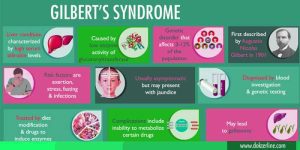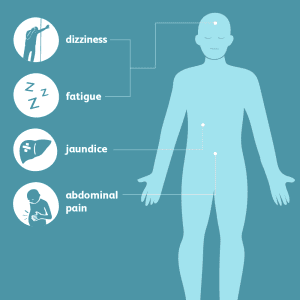What Is Gilbert’s Syndrome?
Gilbert Syndrome, alternatively termed constitutional hepatic dysfunction or familial nonhemolytic jaundice, represents a familial anomaly characterized by the accumulation of bilirubin in the bloodstream. This surplus occasionally manifests as a distinct yellowing of the skin and eyes.

Causes and Risk Factors
- Genetic Underpinnings: Rooted in genetic mutations, Gilbert’s syndrome is intricately connected to alterations in the UGT1A1 gene.
- Enzymatic Cruciality: The UGT1A1 gene encodes a liver enzyme pivotal for breaking down bilirubin, a waste product.
- Hereditary Transmission: The syndrome follows an inheritable pattern, requiring the presence of mutated genes from both parents.
- Gender Disparity: Prevalence leans toward men, making it more common in this demographic.

Symptoms
- Asymptomatic Majority: A significant number of individuals with Gilbert’s syndrome remain symptom-free.
- Jaundice Manifestation: Excessive bilirubin levels may lead to jaundice, noticeable through yellowing of the skin and eyes.
- Ancillary Symptoms: Nausea, abdominal discomfort, fatigue, and dark urine might accompany jaundice.
- Triggered Severity: Symptoms may intensify during periods of stress, dehydration, exercise, infections, and certain medication use.

Diagnosis
- Congenital Nature: Though present from birth, diagnosis often occurs later in life, prompted by routine blood tests indicating elevated bilirubin levels.
- Comprehensive Investigations: Further diagnostic steps may involve liver ultrasound, gene tests to identify UGT1A1 mutations, and, in rare instances, a liver biopsy to rule out concurrent issues.
Treatments and Home Remedies
- Largely Asymptomatic Management: Most individuals with Gilbert’s syndrome do not necessitate active treatment, as jaundice typically poses no long-term complications.
- Lifestyle Adjustments: Implementing lifestyle modifications proves effective in preventing symptom exacerbation.
- Dietary Considerations: Avoiding triggers like skipping meals.
- Hydration Emphasis: Ensuring adequate fluid intake.
- Stress Management: Adopting relaxation techniques.
- Sleep Prioritization: Ensuring a good night’s sleep.
- Alcohol Limitation: Moderating alcoholic beverage consumption.
- Physical Activity Awareness: Avoiding strenuous workouts.

Interactions with Medications
- Cautionary Measures: Individuals with Gilbert’s syndrome should exercise caution with specific medications.
- Enzymatic Drug Processing: The liver enzyme affected by this syndrome is integral to processing various drugs, including acetaminophen, certain cancer medications, and drugs used for HIV and hepatitis C.
- Consultation Prerequisite: Seeking professional advice before incorporating new medications is crucial to minimize potential side effects.

Conclusion
In conclusion, Gilbert’s Syndrome, while rooted in genetic intricacies, often manifests as a benign condition with manageable symptoms. As a familial disorder, understanding its genetic underpinnings is key to diagnosis and proactive management. Lifestyle adjustments, such as dietary considerations, stress management, and moderation of certain activities, play a pivotal role in preventing symptom exacerbation. Timely diagnosis through routine blood tests and comprehensive investigations enables effective long-term care. While largely asymptomatic, caution in medication choices is advised to minimize potential side effects. Embracing a holistic approach that combines genetic awareness and lifestyle modifications empowers individuals to lead healthier lives despite the genetic predisposition of Gilbert’s Syndrome.












